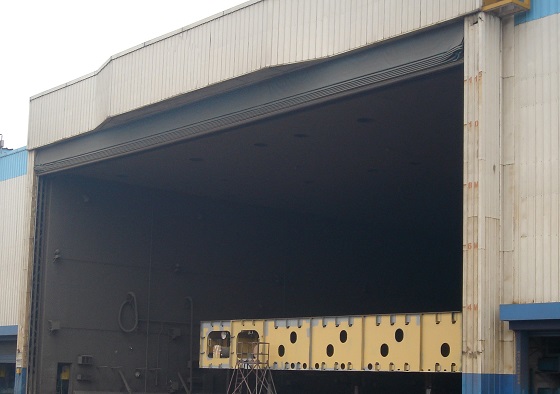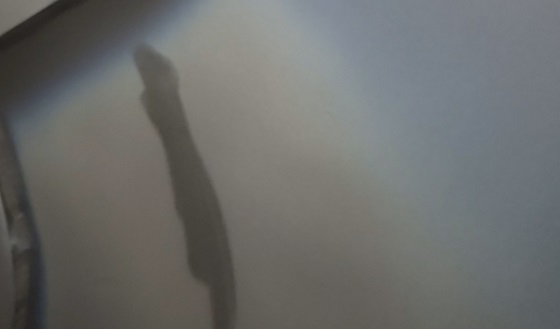Therefore, a pH test was performed on this project, and the resulting high pH values indicated that the surface exhibited an amine blush. This was an unexpected situation, and further investigation was warranted to try to understand why it happened. There are several things to consider:
• The epoxy coatings were applied in an environmentally controlled blast cabinet;
• The epoxy applied was an amine-cured epoxy, which is susceptible to amine blush;
• The blast cabinet used a direct-fired heater to control the environment.
In addition to the pH levels taken at the site, a lab analysis later confirmed that the waxy film was an amine exudate. So, an amine blush did, in fact, form on the coating surface in an environmentally controlled enclosure.
What Is an Amine Blush?
Going forward in the investigation, it’s important to have a clear understanding of how an amine blush forms on a surface. A good, detailed explanation is provided in the following excerpt from the article, “The Formation of Exudate (Blushing) of Epoxy Coatings” by Julia Baur, which provides a pretty good explanation as to the reaction of amine-cured epoxies when exposed to carbon dioxide (CO2) and water vapor:
“Amine-cured epoxies have an active amine functional group that react with the epoxy functional groups in the resin component. Amine exudate (blush) is a chemical reaction that occurs between water, carbon dioxide, and the amine component of epoxy coatings. Amines are hygroscopic, which means that they tend to absorb moisture from the air and are prone to react with available moisture and carbon dioxide.
“From this point, the carbamate continues to react with carbon dioxide and forms ammonium bicarbonate. This chain of reactions can lead to a sticky, oily, or waxy film appearing on the surface of the cured epoxy material, which is largely due to the ammonium bicarbonate salts. If the surface is to be overcoated, the presence of amine blush can act as a bond breaker between the coating layers. The adhesion of the two layers will be severely decreased and will likely lead to coating failure.”
So, can we infer that there was a source of carbon dioxide present on this project? Testing was performed again, and the results indicated carbon dioxide levels in excess of 1,000 ppm with readings of more than 1,500 ppm at times. You may be asking, “What are the maximum acceptable carbon dioxide concentration values that would not cause an amine blush?”

Research generally supports that the values obtained in a blast cabinet with a climate-controlled system heater in use are within the carbon dioxide levels that initiate amine blush on amine-cured epoxies. One publication, “The Amine Blush ‘Phenomenon’” by Tom Vath, provides the following information for consideration:
“Indoor concentrations of CO2 are almost always higher than outdoors. The American Society of Heating, Refrigerating, and Air Conditioning Engineers recommends that indoor CO2 levels be less than 700 ppm above the outdoor value. Average indoor CO2 concentration is typically between 500 and 800 ppm. Therefore, since most epoxy floor coatings are applied indoors, levels of this type are unlikely to cause an issue. When levels above 1,000 ppm occur, the potential for amine blush dramatically increases. When levels are beyond 1,500 ppm, it is highly likely that problems will occur.”
While the article was describing the installation of epoxy flooring, the cause and effect is the same for both situations and materials. In this instance, the cabinet used a direct-fired heater. You may be asking, “How does that compare to an indirect-fired heater?”
A direct-fired heater typically uses a natural gas or propane fuel source to heat the air “directly.” The by-products of combustion are carbon dioxide and water vapor, which are known to cause amine blush/bloom with amine-cured epoxies.
An indirect-fired heater uses a heat exchanger to heat the stream of air. The resulting air that is being used to heat the blast cabinet is not exposed to the fuel and its combustion products, so it doesn’t expose the surface to the carbon dioxide and water vapor contaminates.
The process is well described in a paper presented at the Fall 2001 Epoxy Resin Formulators’ Meeting of The Society of the Plastics Industry, “Amine Blushing Problems? No Sweat!” by Bruce L. Burton, former senior principal scientist for Huntsman Corporation. The paper provides additional insight into the causes of amine blush and supports the contention of the influence of carbon dioxide and water vapor from direct-fired heaters causing amine blush formation.
“The amine compounds used for epoxy curing are often both hygroscopic and very efficient scavengers of carbon dioxide from the air, even though carbon dioxide is generally present at levels averaging only about 350 ppm in outdoor atmospheres. In indoor environments with human activity, the amount of carbon dioxide present may increase by two or three times. In the presence of gas burning motors (e.g., tow motors/fork trucks) or direct-fired gas or kerosene heaters (“salamanders”), the carbon dioxide concentration may be notably higher. Because such direct-fired heaters also produce copious quantities of water vapor, blushing problems may be exacerbated due to condensation of moisture and water spotting may also result.”
Amine blush caused by the by-products (i.e., carbon dioxide and water vapor) of direct-fired heaters interaction with amine-cured epoxies is a well-documented industry phenomenon, though typically as a result of using portable salamander-type propane heaters. These heaters are portable and so named for the folklore of salamanders having an affinity for fire.

If It Looks Like a Duck…
As the saying goes, “If it looks like a duck, swims like a duck, and quacks like a duck, then it probably is a duck.” The situation presented within the blast cabinet described in this story produced a situation causing amine blush is not typical, but it clearly illustrates that the “devil is in the details.” All aspects of a design need to be carefully considered.
Just because the coating was applied in a “controlled” setting doesn’t mean that all variables were accounted for. In fact, not only did it continue to happen after they brought me in to investigate, but we also recreated it on the test panels.
To avoid this type of problem happening in the future — in a cabinet or in the field — applicators need to follow a few basic tenants to start:
• Consider the coating. There might be a better product formulation choice than the amine-cured epoxy. The “sweat-in” time for the epoxy products may have a contributing effect as well.
• Consider the environment. In this case, the effect was exacerbated by the heater’s use during wintertime. The problem may not manifest itself during the balance of the year.
In this instance, after confirming that there was indeed an amine blush problem, the contractor determined that the amine exudate needed to be removed effectively to ensure the adhesion of subsequently applied coating materials. They had to closely watch the atmospheric conditions going forward to make sure that the heater didn’t cause further troubles. The final result: There was no delamination of subsequent coatings after the amine blush was removed.
Editor’s note: This article first appeared in the July 2024 print issue of CoatingsPro Magazine. Reprinted with permission.